Project Tass (Tactical)
POST MORTEM
15 min read
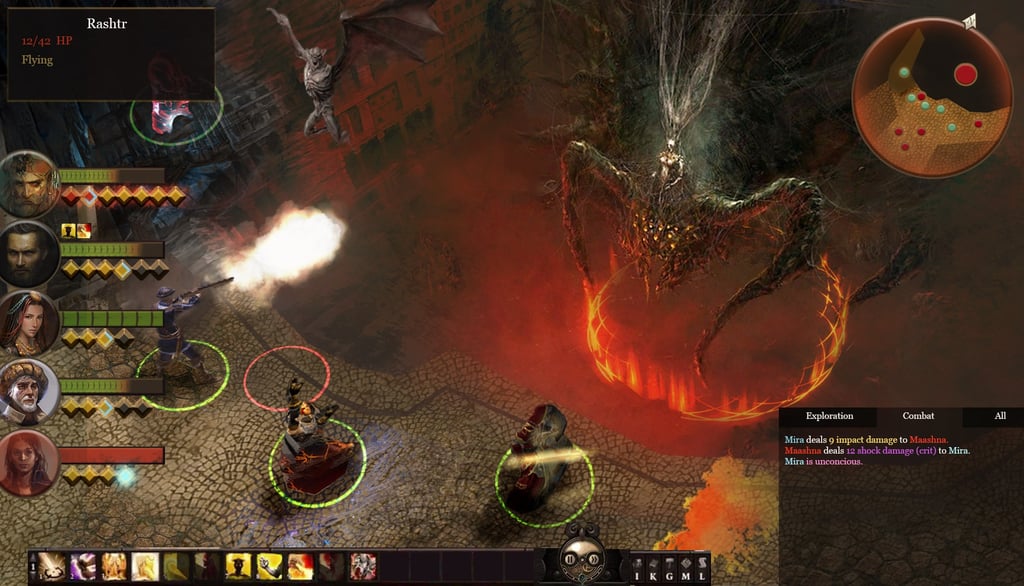

Project Tass is an ambitious reimagining of Tactical design staples with modern inspirations and which includes systems such as:
A dynamic initiative system that simulates a short period of rest after using a big ability.
Tass: a resource that characters can generate and use, capable of reaching "Overcharge", changing how some abilities function entirely - thus achieving greater Tactical options with powerful spells.
A tiered Status Effects system and Grit Challenges, replacing randomness commonly found in the genre with a more controled puzzle challenge for players.
A small twist on common card draw mechanics.
Innovative progression systems with esoteric inspirations, and more...
1 - A fundamental reimagining
Tactical are one of my favourite genres, and naturally, over the years, I’ve had a fantasy of changing things around in the basic formula.
Common issues I had with the genre before include:
A big part of randomness in placing powerful Status Effects like Stun on enemies, which can often decide a fight on turn 1 with no interactivity, thus encouraging save scumming and making competitive PvP unviable.
A lack of teamwork between characters of the same faction and an often small emphasis on positioning tactics.
Bland abilities and a lack of building up to a spectacular moment in the fight.
No feeling of effort made by the characters when casting powerful abilities.
I wanted to remedy that.
Initial inspirations: It all starts with Emotion at the source of Design. Before I imagined Project Tass, I had created a pen & paper RPG system called 'Heroism' which aimed to fix many of the same problems I found while playing Dungeons & Dragons 5th edition. In Heroism, the emphasis was given on transmitting a feeling of Effort and Heroic Actions while promoting teamwork among heroes. It was that same feeling that I built on to create the systems of Project Tass.
I was inspired by the setting I had created for Yanshu, where mages take Salt (small fragments of souls) to use magic - with the risk of becoming Saturated. For Project Tass, I wanted to promote a feeling a competency above one of risk, and so the saturation instead became the mechanic of Overcharge, which makes abilities more powerful once attained, and sometimes even modifies a skill's behaviour entirely, but which has a great cost. Knowing when to reach Overcharge and which ability to spend your Overcharge on (depending on the unique Tactical puzzle of the current fight) would be a key loop in the gameplay of this game.
A. Tass, Initiative, and Overcharge
Where it all started: Mockup of 'Yanshu', a real-time-with-pause RPG that would become the original inspiration for Project Tass, with its saturation mechanic, class identities and multiclass system.
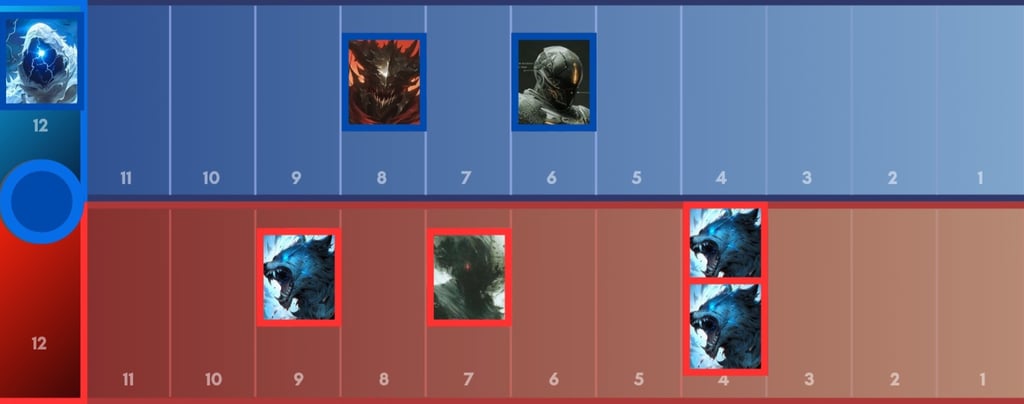

The dynamic initiative system of Project Tass.
Similar to a Barbarian in Diablo 3, characters in Project Tass have abilities which build up their resource (Tass Generators) and abilities which spend Tass (Tass Spenders); When reaching the maximum value of 12 Tass, the character enters Overcharge, which turns all of their next ability into one super-powered spell, costing a lot of Tass.
Tass is not just a resource though, it is also a score which counts as Initiative, shuffling the turn order dynamically: every turn, the characters which had previously used a lot of small tass-generating abilities will likely play first, while those who had spent their last turn on a big tass-spending ability will have their Tass score reduced, and likely will play later in the turn. This, I found, was a great way to simulate that feeling of Effort I was chasing in my design, and it was a great puzzle for players to plan around: "how do I arrange to manipulate the turn order in my favour when the time counts ?".
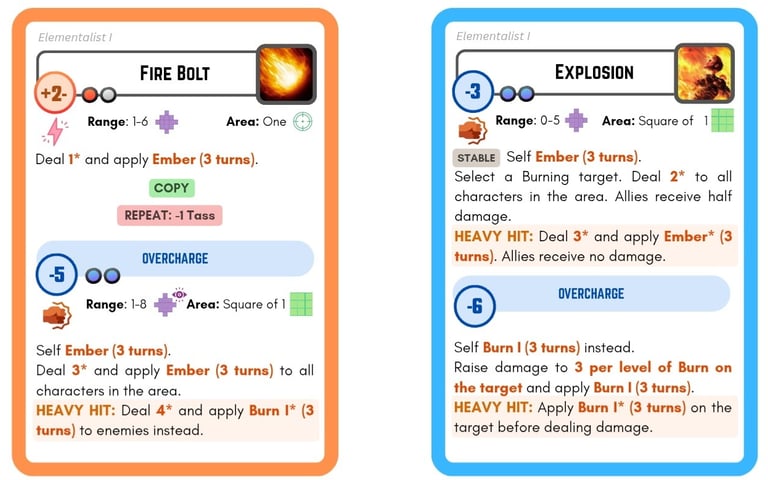

An example of Overcharge in cards made for the paper prototype of Project Tass (Note: there is a lot of text in the cards, this is because each card is in reality 2 or sometimes more abilities - which a computer would otherwise handle based on context).
B - A small twist on card draw
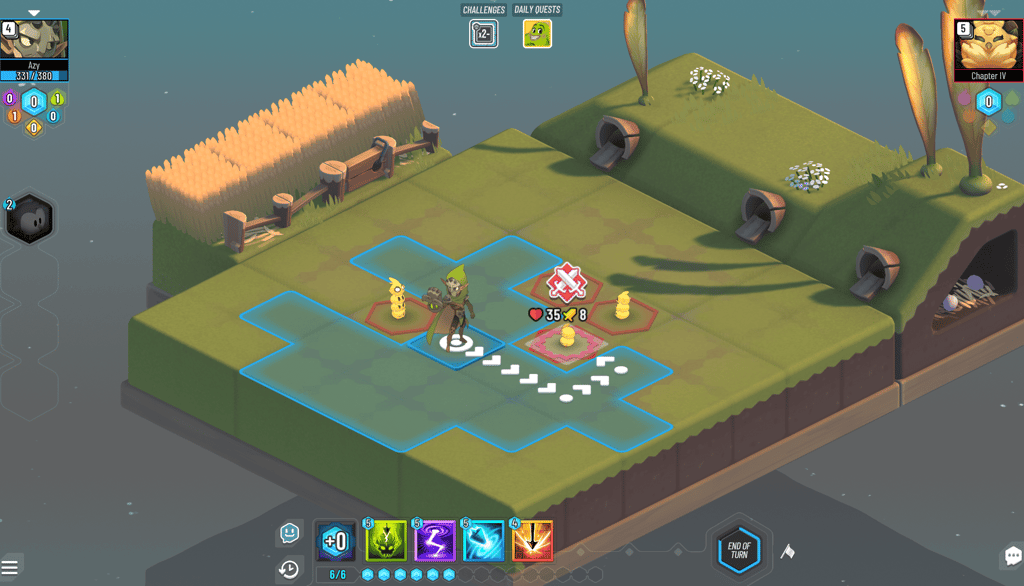

Game inspiration: ’Waven’, which combines tactical and card-game elements.
For all game enthusiasts born in France in the 90s like I was, our entry into MMORPGs were the Tactical games Dofus and Wakfy made by French developer Ankama. To us at this time, this was our World of Warcraft, and remains today a reference in the genre as a great tactical game which has evolved over a whole 20+ Years ! I believe this unique cultural baggage is part or why many great Tactical games came out in recent years from France and Belgium, the likes of Expedition 33, Baldur's Gate 3, and The Dungeon of Naheulbeuk (the lead designer on Expedition 33 was a former designer on Dofus after all!).
One of the direct motivations for me to make project Tass was learning about Ankama's new project - Waven - which iterated on their trademark Tactical formula by adding card game mechanics - but - while I thought it was a great concept, I found Waven to be disappointingly (for me) catering to a casual mobile market, while I felt the urge to transform these concepts into something that would give more meat to a core audience.
In Project Tass, on top of previously explained systems, I had an intuition of using a new kind of draw mechanic - and after testing it, it turned out to be great.
Each character has a score of Wisdom which translates into how many cards a characters draws at the beginning of each turn. They are free to use their cards up to a number of action points; after which, cards left unused at the end of the turn become Wildcards - one of which can be used on the following turn.
This system, in my playtests' findings, achieved multiple things:
Removed a lot of the randomness that comes from top-decking by giving a lot of cards to draw each turn.
Made players think about their next turn by considering which of their cards will become Wildcards.
On top of their Wisdom, players have a 'Wits' stat which refers to "prepared cards". This can be items (such as potions) but also cards which are guaranteed to draw on turn 1 - this way, players have reliable start to the game, so they can unleash the full potential and fantasy of their class (not getting necessary cards on turn 1 can be like drawing a wet fireworks - and encourages save-scumming which we want to avoid).
Additionally, characters have access to a "sphere ability" which - for level 1 characters - is a draw or search engine to make hands more reliable.
With these systems in place I felt I achieved a great balance between the satisfaction of adapting to random events by drawing cards and the reliability inherently necessary to achieve the chess-like nature of a great tactical game. I distinctively felt that "click" when almost each turn, my brain was working to solve a fun puzzle that is slightly different every time (a lesson learned from my time prototyping a Roguelike game built around the Pomemon TCG !)
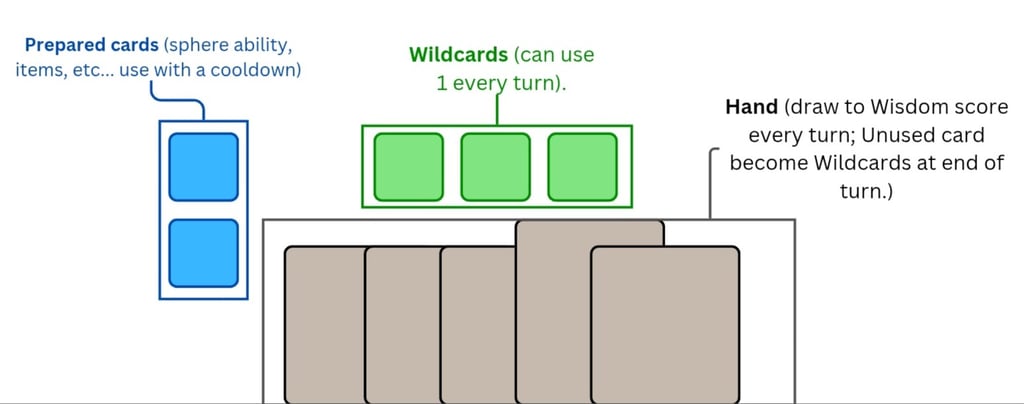

Explaining the card system of Project Tass
C - Statuses, Grit, Defense and Break
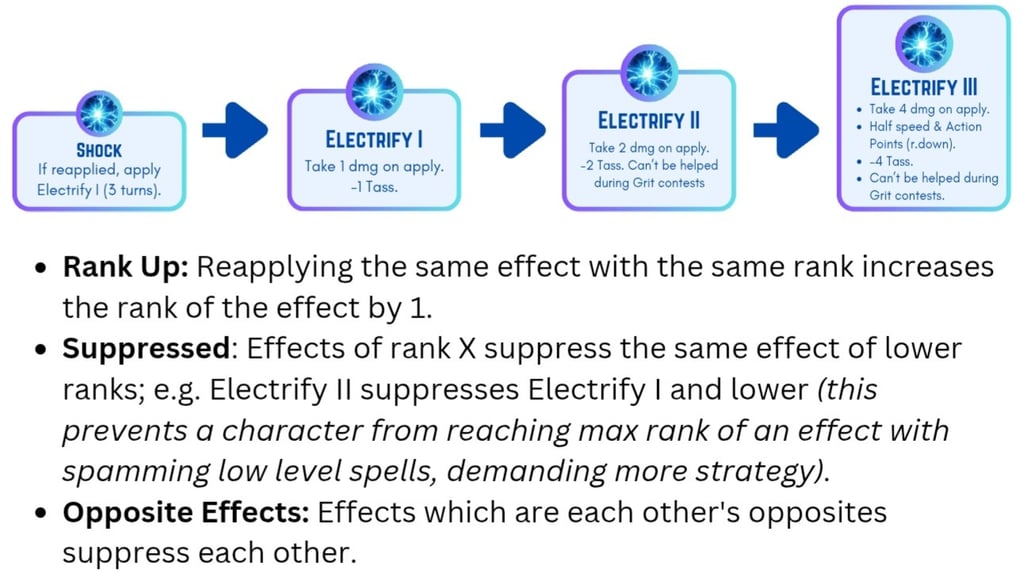

One experience which I feel commonly ruins the balance of Tactical RPGs is the status effect system. For players accustomed to the genre, we've all experienced this scenario:
Turn 1, my ability has a 40% chance of stunning the enemy.
Fail.
Reload and repeat until I hit a random chance of success.
Succeed, the fight is already decided before my enemy could even play.
This, to me, sucks. Randomness - while it can stimulate excitement in small doses - can also destroy the fun inherent to building a character around certain strategies, planning and carefully executing that plan - sometimes it can ruin the balance of a game, making many of our build and Tactical decisions useless - especially when they impact (in the case of a Stun) something as critical as action economy.
I was determined to solve that problem with Project Tass. Previous attempts I had seen to solve this problem had been flawed. In Dofus, the pressure of a PvP scene, over the years, made disappear most abilities which severely impacted action economy - but in turn, sacrificed the spectacular moments which can be born from using such potent abilities. Divinity Original Sin 2 came up with the Physical / Magic armor system, which prevents effects from being placed on characters as long as they are present, but limits diversity in party compositions and makes using Status Effects at all awkward - giving an excessive importance early in battle to dealing damage, and then, because enemies without armor are already near death, the focus remains damage. That 0 to 1 switch reliant purely on dealing damage felt ineffective and was met with negativity from players.
Here are the solutions Project Tass came up with:
Each status effect is spread over 3 ranks, with varying levels of potency around the same theme.
Each character has a score of Defense. While Defense is active, characters will generally suffer statuses of rank 1 and 2, but rarely 3.
Some abilities (usually Tass Spenders and Overcharge abilities) have the capacity to begin a Grit contest.
A Grit contest involves all characters near both the caster and the target of the spell (a great way to achieve the feeling of teamwork I was looking for, while also rewarding careful positioning !). The Grit stat of all participating characters is compared (on top of a roll of dice for suspense) to determine the winner of the contest.
If the attacker succeeds in their challenge, their skill is a Heavy Hit, applying a greater effect on the enemy, and reducing their Defense by 1.
When a character's defence goes to 0, they become Broken: all attacks against them are automatically heavy hits - giving the opportunity for the attacker to put a maximum rank effect (like Stun) on their target, in a spectacular attack while their enemy has their Defense down.
The goal of a well-planned attack then, becomes to have your characters reach Overcharge - when they are at their strongest - at the same moment your enemies are Broken - when they are weakest. Overlapping both these moments can lead to spectacular coordinated attacks which form the climax of a well-executed plan - that kind of high-variance in intensity during combat - that rush of excitement when multiple things fall into place and multiply each other - that's the Zing we want to achieve in game design: that memorable moment players will never forget and which will make the rounds as a spectacular moment on social media shorts.
Besides the emotional goal, this Defense, Break, and Tiered Effects system achieves a very practical goal compared to other tacticals: it slows down the early game and accelerates the late game (for which I even added a Team Break system - meant to accelerate the clean-up of a fight which is already won). This ensures that the early game be dedicated to Tactical considerations and avoid the pitfalls of "damage is King" often found in such games in which battles can often be decided on Turn 1.
Example of a Tiered Effect in the paper prototype of Project Tass.
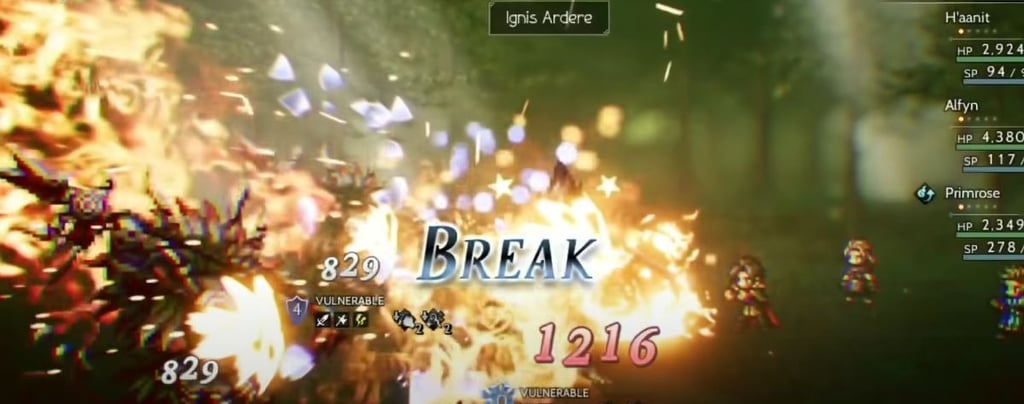

Game inspiration: Octopath Traveller's Break system - where the player has to plan their strongest attacks for their enemy's weakest moment (something which fits Project Tass' Overcharge system perfectly !)
2 - Building a Paper Prototype
Because this game is very system-heavy, I decided to opt for prototyping on paper at first, and in just a few weeks, I was able to test all of my main combat features, test multiple combat scenarios, a diversity of player and enemy class designs, make radical balance changes and specify nitty-gritty design problems on the fly; overall, I'm very happy I made that choice, as doing the equivalent on a digital prototype would have been much slower and difficult - here, I could focus all of my brain matter on pure design.
A - Arena 1: Core Mechanics
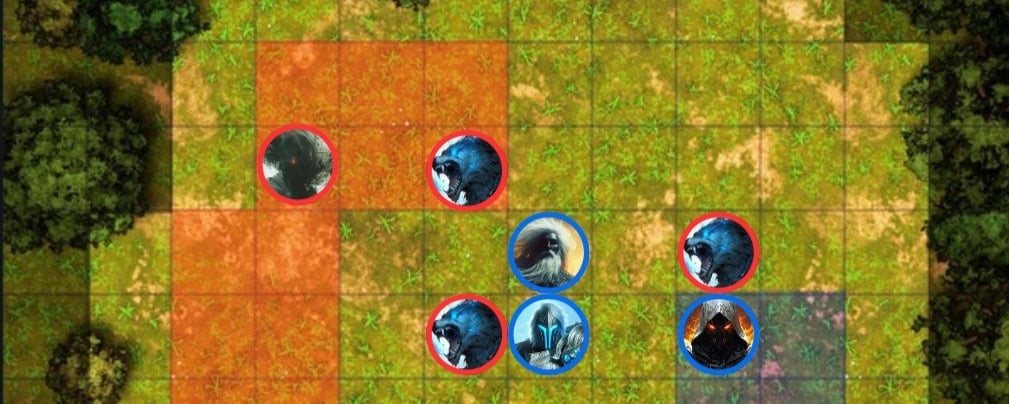

Testing Arena 1 for Core Mechanics
First, the great confirmations:
The Draw system WORKS - my brain felt engaged thinking about which Wildcards I would have access to next turn, or about which cards I could draw into this turn if I used my sphere ability; more importantly, the cards I was drawing fulfilled the design goal of giving that zest of adapting to random situations on the fly all the while being abundant enough that I felt I can reliably fulfill my class' gameplan.
The dynamic initiative system is FUN - it felt like my characters were playing Mario Kart on the side of the initiative board, trying to cross each other on the turn order to play before their opponents in critical moments.
Grit Challenges fulfill multiple fantasies: Rewarding good positioning, Feeling like teamwork, and serving as controlled critical hits that offer both a little randomness and a way to influence that randomness with buffs and debuffs.
The things that needed a bit more work:
Balancing the Action Economy: at first, I tried having all characters with 2 AP, and it didn't feel good; I could analyse that sensation as follows: "My turn doesn't feel impactful enough", "I'm not making enough decisions, or not complex enough decisions, and my mind is not engaged enough as a result". I solved those problems by doubling the AP of characters - rebalancing all abilities in consequence - not only that, but I found a way to fulfill a fantasy I was aiming for by giving a different amount of AP to different qualities of characters:
Player characters and elite enemies would have 4 AP, minions 2, normal enemies 3, and bosses upward of 5, 6 or even 8 AP ! As a result of my testings, this design felt good; not only had I found a way to bring more granularity in enemy designs, the overall game felt BETTER, I hit that Click moment when I was having fun playing my turns, making complex and meaningful choices, and feeling like my turns had great impact while leaving enough leeway for reactivity.
More Balancing was done quickly thanks to the paper prototype and complex rules such as "which order does this chain reaction trigger ?" could be adapted and tested on the fly. I balanced the first arena to be over in 2 to 3 full turns, serving as a tutorial for basic systems. I also asked myself "how often do I want my characters to go into Overcharge?" (each class had a different answer to that question) "what's my Time to Kill?" etc..., making dozens of changes to abilities every day until it felt good to play - knowing already that my fundamental systems were a solid foundation for higher level iteration.
Arena 2: Elevation, Cover, Defense & Break
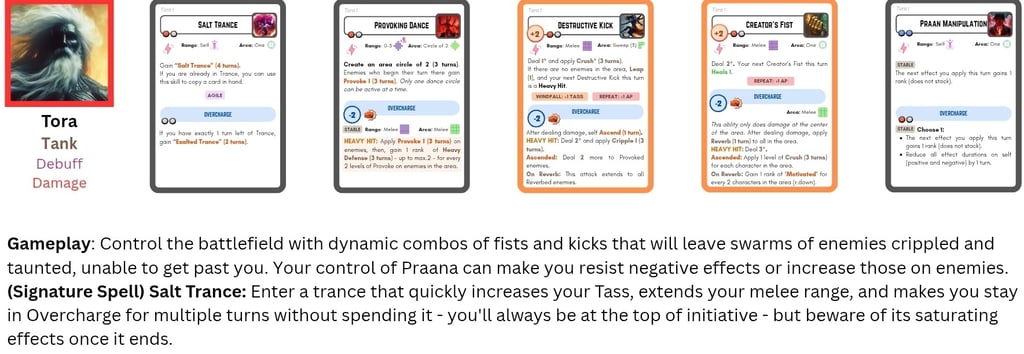

Example level 1 character kits - 8 Classes were designed in total for the paper prototype, up to level 2 (which adds a passive + 2 actives to the level 1 kit).
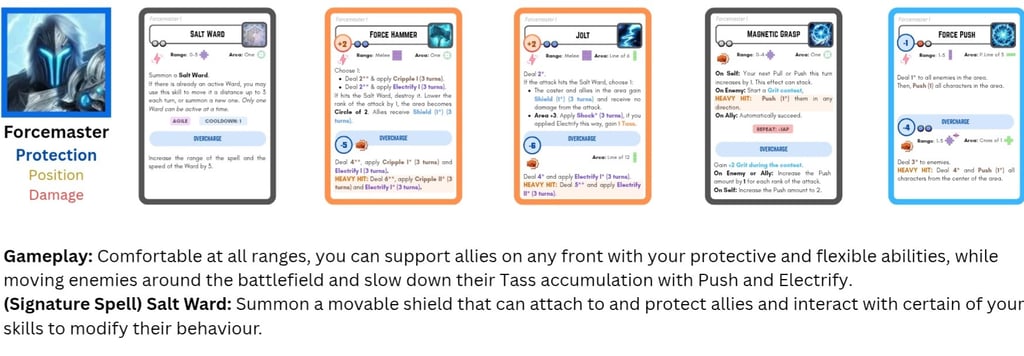


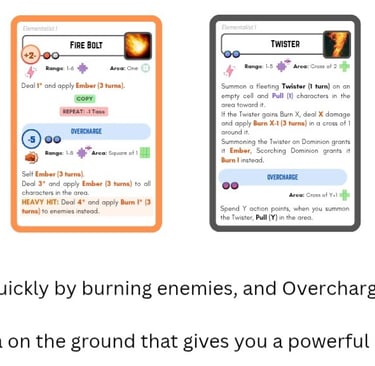
D - Designing with Constraints
The game was LARGE, with many tools in my toolbox, I thought it would be a good idea to bring constraints that would both limit the design field and define different archetypes with more distinct personalities.
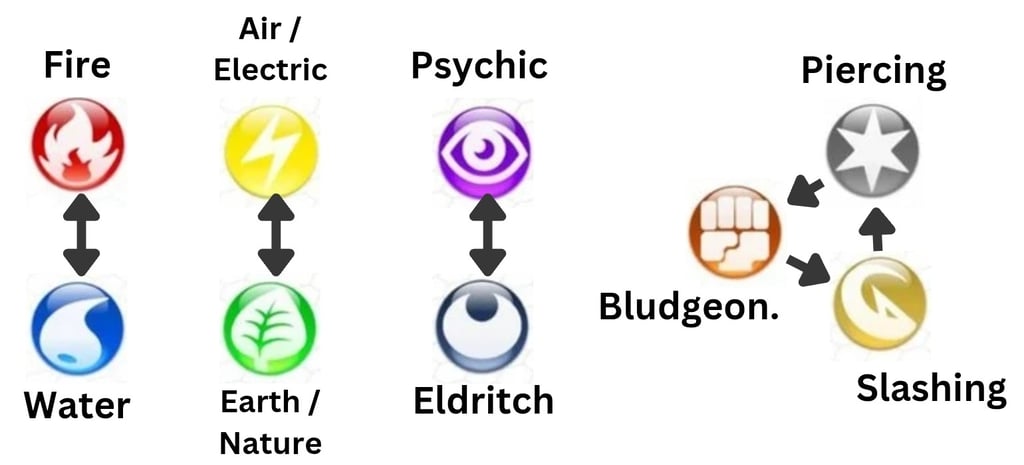

The elements map & how they counter each other
It felt natural to me to associate certain status effects with certain elements; then, I decided to give each class an access to a maximum of 2 elements - in this way, each class would be designed with a limited number of effects in mind. The design maps for the paper prototype looked something like this:
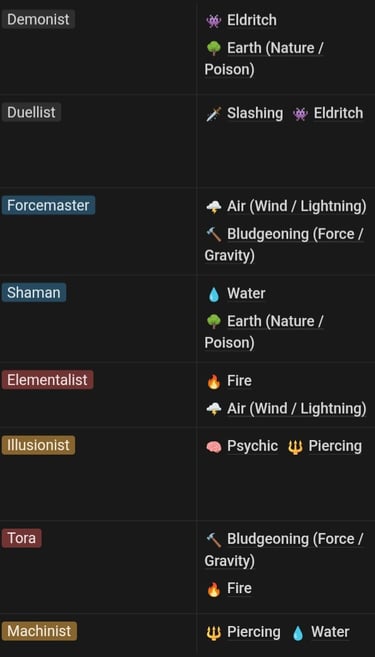

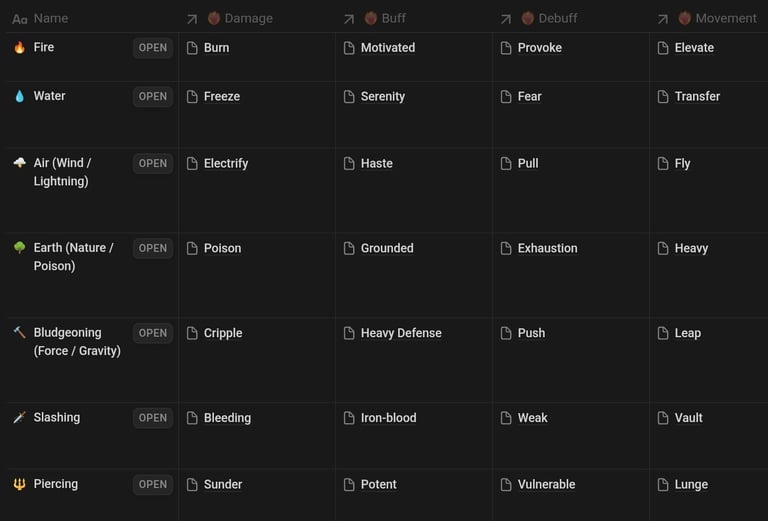

Class - Elements map
Elements - Statuses map
This shared design constraints led to a faster design cycle for classes as well as a good way to balance them with each other (since they have access to the same number of tools which are meant to be of equivalent strength).
Class Design Philosophy
As I tested the first arena, I became more intimate with the relationship between the fundamental systems of the game and class designs. As I iterated on abilities during testing, here are the questions I would ask myself during class overhauls:
What are the fantasy and themes of this class ? (I usually have a movie in my head of how this class plays, and most importantly, a FEELING that I want to achieve).
Which systems are this class' strength, which systems does it struggle with ?
What is this class' signature skill ? (A signature skill is one designed to greatly influence the way this class plays and is purposefully stronger on paper than other skills)
Which 2 elements does this class use, and from these elements, which status effects can fulfill its class fantasy ?
What does a typical turn look like if this class wants to:
Build Tass: to get in Overcharge quickly.
Prep: to setup an enemy to receive a max-rank status effect, move quickly to an objective, support an ally, buff self, etc... (adapting to the current Tactical scenario or moving toward your own Nova turn).
Nova: Dealing lots of damage, placing a max-rank status effect, generally taking advantage of your own Overcharge and Buffs & your enemy's Break & Debuffs.
Taking this approach helped me achieve strong fantasies for classes, and balance abilities in a way that is turn-focused: meaning each turn feels good to play.
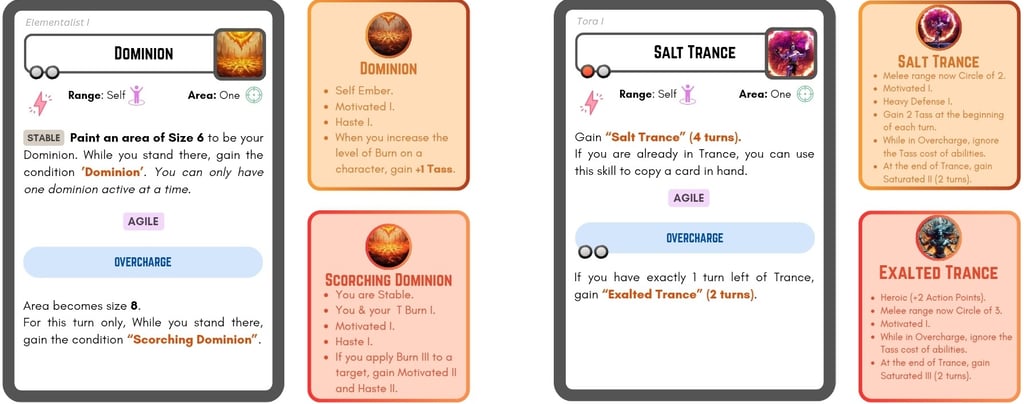

Example signature skills - core to fulfilling a class'fantasy in combat
After securing strong fundamental systems and a good enough balance on Base classes, it was time to push things further by adding supplementary systems, manely: Defense, Break, Elevation & Cover - all of which interact with each other on some level.
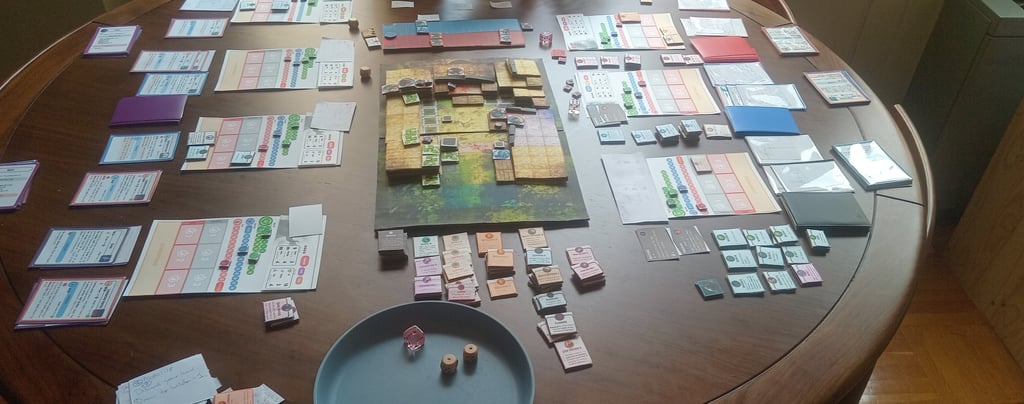

Paper Prototype of Arena 2
I remember arena 2 at first didn't feel good, and because a lot of new things were going on, it was hard to identify what the problems were and if they were stemming from class balance, level design issues, or fundamental system problems - and on some level, I knew it was all of them; so I took time with it until I knew I had achieved what I wanted and it Clicked.
Recently, game design has felt to me like being a cook, wherein you adjust the Salt and Acid balance until you get that nondescriptive feeling of Zing - you just know it works - and that's the kind of feeling I've been chasing in my designs once I know that the design boudaries I set for myself are good - designing with a balance of pragmatism and feelings.
Here are some of the major changes I made during testing arena 2:
Increased the base speed of melee classes and added a Dash action: Arena 2 was twice as big as arena 1, and with the addition of obstacles and elevation, melee classes were struggling; the way movement worked needed some adjustments.
Redesigned level design in small ways to further help melee classes navigate around and reach sheltered enemies.
Reworked some defensive buffs and the general way status effects worked in a way that interacted more with the covered/exposed system and addressed how strong status effects were in general at the time in all situations.
After these changes, I had a better picture of how the systems I added felt in isolation, and overall I liked them.
Elevation and Cover added more Tactical incentives for good positioning and created more variance in the intensity of attacks, with higher highs and lower lows - a win.
Defense and Break fulfilled its intended role: Slow down the early game, accelerate the late game, and enable spectacular turns the player can plan for.
Playtests and Conclusions
I tested the paper prototype at that point with 2 of my game designer friends and was met with general enthusiasm. One of them had mixed feelings, sharing that
Status effects in games are generally off-putting to him (okay, maybe he's not the intended audience, I always thought I wanted the game to be more challenging than most tacticals, while having difficulty settings adjusted for people who only want to throw out what cards they have without much consideration - and still for cool things to happen thanks to the chain-reactions of the status effect system even if they didn't plan for it).
He also had some concern about how the defense & break system would scale up to longer games, especially since it can become a "lose-more" mechanic for players - fair; but I wasn't too worried about that either, considering the break system is mostly inspired by Octopath Traveller and I saw it work great there; I felt it would mostly be a balance issue, and largely, if it ever did become a problem in the future, I already knew it would be a problem with a thousand different solutions that wouldn’t need to sacrifice the core vision. I wasn't worried.
All in all, both of them told me I had achieved nearly everything I could with the paper prototype, that it was on the threshold of being too complex to be played without a computer to automate the systems (which I was aware of), and they both encouraged me to continue with a digital prototype, as the fundamentals felt both good and innovative.
Next steps:
Two arenas which I hadn’t had time to test before showing to my game designer friends were the 3v3 PvP and a Boss Fight, which would both bring characters to level 2, bring in more abilities and classes, and push the systems further. I wanted to see how the systems I built would behave on fights the player can lose - since both arena 1 & 2 were designed to be easy, serving as tutorials. Continuing with those 2 scenarios felt like it would be able to cement some of the details of systems before pushing them to a digital prototype.
Then, when both winning and losing would feel fair and good, the game would be ready for a digital prototype.
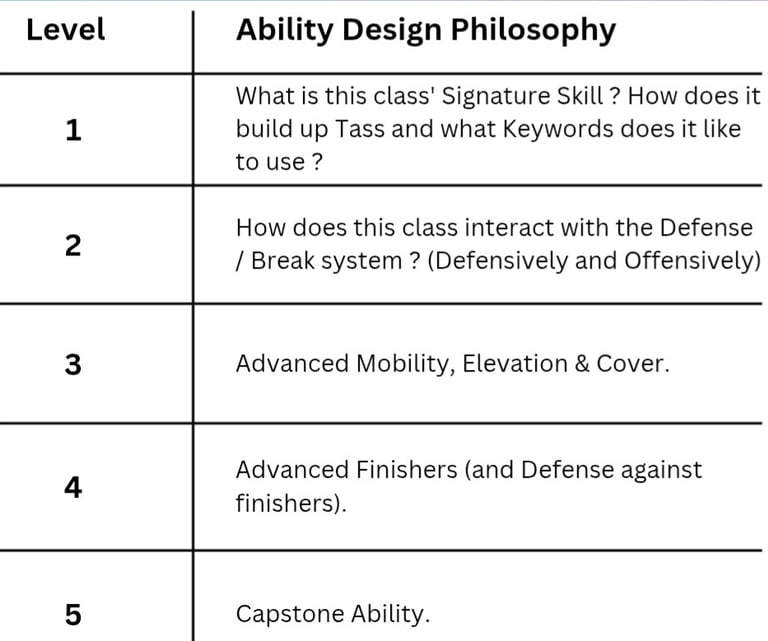

Ability design philosophy per theme mapped on characters levels.

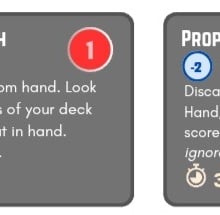
Examples of Passives, Sphere Abilities, and Items.
Connect
Let's collaborate on your next game design project:
damien.f.rodriguez@gmail.com
© 2025. All rights reserved.